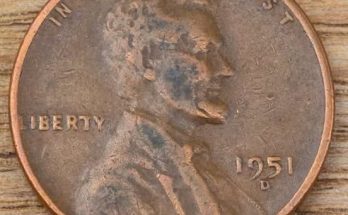If you’ve ever emptied your change jar and glanced over the pile of coins, you might want to take a second look — especially if you spot a 1967 Roosevelt dime. What most people see as a simple 10-cent piece could actually be worth up to $300,000 in certain rare cases. Coin collectors and numismatic enthusiasts across the world are scrambling to find this elusive dime, and its value keeps skyrocketing as more people learn about its rarity and historical significance.
This coin, minted in 1967, holds a special place in U.S. coin history. It was produced during a time of major change in the American Mint — when silver coins were being phased out and replaced with copper-nickel clad compositions. This transitional period resulted in several rare minting errors and variations, some of which are now commanding astonishing prices in the collector’s market.
Why the 1967 Dime Is So Special
At first glance, the 1967 Roosevelt dime doesn’t appear to be anything unusual. It features the familiar profile of Franklin D. Roosevelt on the obverse and a torch flanked by an olive branch and oak branch on the reverse. However, the real treasure lies in its minting errors and rare variations.
During 1967, the U.S. Mint did not include mint marks on dimes — meaning there’s no “D” for Denver or “S” for San Francisco on the coin. This decision was made to discourage coin hoarding during a period of metal shortages. But despite this, some experimental strikes, proof-like errors, and off-metal compositions slipped into circulation. These unique mistakes are what make certain 1967 dimes so valuable today.
Types of Rare 1967 Dimes That Collectors Crave
-
Full Bands (FB) Dimes
On the reverse side of the Roosevelt dime, the torch has horizontal bands. If these bands are fully struck and show complete separation lines, it’s considered a “Full Bands” (FB) dime — a highly sought-after detail among collectors. A 1967 dime with strong FB details in pristine condition can fetch thousands of dollars. -
Double Die Error
One of the most valuable types of minting errors is the double die, where parts of the coin’s design appear doubled due to a misalignment during the minting process. A 1967 dime with visible doubling on the date, lettering, or Roosevelt’s profile could be worth tens of thousands depending on condition. -
Off-Center Strikes
Coins that were struck off-center — meaning part of the design is missing or misaligned — are rare and collectible. Depending on how much of the design is visible, an off-center 1967 dime can command a hefty premium. -
Wrong Planchet Errors
Sometimes, a coin is mistakenly struck on a blank intended for another denomination, such as a penny or nickel. These “wrong planchet” dimes are extremely rare and can easily exceed $100,000 in auctions. -
Proof-Like or Special Mint Set (SMS) Coins
While the U.S. Mint didn’t produce standard proof sets in 1967, they did issue Special Mint Sets (SMS) with higher-quality strikes. Some of these coins have a mirror-like finish and incredible detail, making them more valuable to collectors — especially if preserved in near-perfect condition.
How to Identify a Valuable 1967 Dime
Before you rush to sell your dime, it’s important to know how to spot the signs of value. Here are some quick steps:
-
Examine the Condition: Coins are graded on a scale from Poor (P-1) to Perfect Mint State (MS-70). A 1967 dime in MS-67 or higher can be worth hundreds even without an error.
-
Look for Errors or Doubling: Use a magnifying glass to inspect the date, lettering, and design details for signs of doubling, misalignment, or missing elements.
-
Check the Finish: SMS coins have a satin-like sheen with fewer marks. If your dime looks unusually shiny or proof-like, it may be from a Special Mint Set.
-
Weigh the Coin: Standard 1967 dimes should weigh about 2.27 grams. A significantly different weight could indicate a wrong-planchet strike — a major rarity.
What Makes the $300,000 Dime So Unique?
The specific dime rumored to be worth around $300,000 is believed to be a rare minting anomaly — possibly a transitional error or a proof-like coin struck on a silver planchet (a leftover blank from earlier years). These ultra-rare pieces are virtually impossible to find in circulation today, but stories of lucky finds continue to surface, keeping treasure hunters hopeful.
Even without an extreme rarity, a pristine 1967 dime from a Special Mint Set can sell for $50–$500 depending on its grade. But the true jackpot comes from those few error dimes authenticated by grading companies such as PCGS or NGC, which have proven provenance and exceptional minting anomalies.
Should You Sell Now or Hold?
Coin experts advise that the market for rare dimes is hot right now. Prices for high-grade and error 1967 dimes have been climbing as collectors compete for the few remaining examples. However, values can fluctuate as new discoveries are made. If you own a potentially valuable 1967 dime, it may be wise to get it professionally appraised and graded before selling.
The demand for historical coins like this continues to grow, and early sellers could capitalize before prices stabilize. Whether you’re a casual coin enthusiast or a serious collector, checking your change might just lead you to one of the most incredible discoveries in modern numismatics.
Final Thoughts
The 1967 dime may look ordinary, but it’s a powerful reminder that history — and value — can hide in plain sight. From its unique place in U.S. minting history to the mysterious errors that made it famous, this dime continues to fascinate collectors around the world. If you happen to come across one, especially with visible minting errors or proof-like quality, you could be holding a coin worth thousands — or even hundreds of thousands — of dollars.
So, take another look at your change jar — because that small silver-colored coin might just be your $300,000 treasure.



